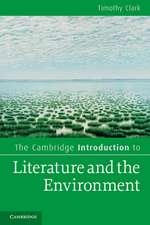Hurt and Pain: Literature and the Suffering Body
Autor Susannah B. Mintzen Limba Engleză Hardback – 4 dec 2013
| Toate formatele și edițiile | Preț | Express |
|---|---|---|
| Paperback (1) | 256.20 lei 6-8 săpt. | |
| Bloomsbury Publishing – 17 iun 2015 | 256.20 lei 6-8 săpt. | |
| Hardback (1) | 772.58 lei 6-8 săpt. | |
| Bloomsbury Publishing – 4 dec 2013 | 772.58 lei 6-8 săpt. |
Preț: 772.58 lei
Preț vechi: 989.75 lei
-22% Nou
Puncte Express: 1159
Preț estimativ în valută:
147.83€ • 154.36$ • 122.07£
147.83€ • 154.36$ • 122.07£
Carte tipărită la comandă
Livrare economică 15-29 aprilie
Preluare comenzi: 021 569.72.76
Specificații
ISBN-13: 9781441174482
ISBN-10: 1441174486
Pagini: 208
Dimensiuni: 156 x 234 x 18 mm
Greutate: 0.45 kg
Ediția:New.
Editura: Bloomsbury Publishing
Colecția Bloomsbury Academic
Locul publicării:London, United Kingdom
ISBN-10: 1441174486
Pagini: 208
Dimensiuni: 156 x 234 x 18 mm
Greutate: 0.45 kg
Ediția:New.
Editura: Bloomsbury Publishing
Colecția Bloomsbury Academic
Locul publicării:London, United Kingdom
Caracteristici
An
in-depth
analysis
of
pain's
representations
in
literature
from
the
17th
to
the
21st
Century.
Notă biografică
Susannah
B.
Mintzis
Professor
of
English
at
Skidmore
College
in
Saratoga
Springs,
NY.
She
is
the
author
ofUnruly
Bodies:
Life
Writing
by
Women
with
Illness
and
Disabilityand
co-editor
of
a
critical
volume
on
the
essayist
Nancy
Mairs.
Cuprins
1.
Introduction
2.
Our
Stories,
Our
Pain:
Autobiographical
Utterances
3.
The
Drama
of
Pain:
Plays
and
Performance
Art
4.
The
Poetry
of
Pain:
Hurting
Made
Lyrical
5.
The
Shape
of
Pain:
On
Narration
and
Plot
6.
Bystander
Pain:
On
Witnessing
and
Touch
7.
Conclusion
Index
Recenzii
Mintz
points
to,
and
develops,
the
work
of
Dickinson
scholars
such
as
Marianne
Noble
and
Michael
Snedicker,
reassessing
common
interpretations
of
certain
poems.
Mintz's
extensive,
intricate
knowledge
of
Dickinson's
work
[in
particular]
...
offers
new
critical
insight
into
the
poet's
hurt
and
pain.
Mintz offers a stimulating book that is convincing in its use of inspiring individual observations and its unusual combination of primary texts ... Her study provides a wealth of starting points for further interdisciplinary studies.
Susannah Mintz brings together poetry, memoir, drama and fiction to show that pain is "inescapable" and "magnificently variable" in the many ways it can destroy and affirm the power of language and selfhood. Discussing writers from John Donne and Emily Dickinson to the present day, she sets the personal experience of pain in tension with the medical understanding of pain. An informed, provocative, important book.
After Elaine Scarry, it has become commonplace to say that pain defies expression - that it is essentially a private, and thus isolating, phenomenon. But, as Susannah Mintz demonstrates in this original, economical, and compelling study, creative writers have long brought their talents to bear on this inevitable human experience, rendering it according to the capabilities of various genres. Literature is no antidote to pain - no anodyne - but Mintz shows how the literary communication of pain may help us live through it and with it. A richly nuanced, beautifully written, and surprisingly heartening book.
A brilliant analysis of pain refracted through genre, Hurt and Pain operates as itself a kind of pain scale-it weighs, measures, and strikes chords of familiar dissonance. In this pain-averse culture, those of us who wake up in pain every morning may feel in the wrong, blame-worthy, alone. Susannah Mintz intervenes in such ableist conceptualizations, offering community and solace through a kaleidoscope of aching, stinging, limping, grieving texts. Mintz resists the transcendence paradigm that tells us to rise above-or get over-our pain, reminding us through careful readings of poems, plays, novels, and memoirs that, beyond good and bad or right and wrong, pain is interesting. Far from the dismissive truism that misery loves company, Mintz clearly demonstrates that the literature of pain is, for many readers, a source of psychological support and palliative touch.
Mintz offers a stimulating book that is convincing in its use of inspiring individual observations and its unusual combination of primary texts ... Her study provides a wealth of starting points for further interdisciplinary studies.
Susannah Mintz brings together poetry, memoir, drama and fiction to show that pain is "inescapable" and "magnificently variable" in the many ways it can destroy and affirm the power of language and selfhood. Discussing writers from John Donne and Emily Dickinson to the present day, she sets the personal experience of pain in tension with the medical understanding of pain. An informed, provocative, important book.
After Elaine Scarry, it has become commonplace to say that pain defies expression - that it is essentially a private, and thus isolating, phenomenon. But, as Susannah Mintz demonstrates in this original, economical, and compelling study, creative writers have long brought their talents to bear on this inevitable human experience, rendering it according to the capabilities of various genres. Literature is no antidote to pain - no anodyne - but Mintz shows how the literary communication of pain may help us live through it and with it. A richly nuanced, beautifully written, and surprisingly heartening book.
A brilliant analysis of pain refracted through genre, Hurt and Pain operates as itself a kind of pain scale-it weighs, measures, and strikes chords of familiar dissonance. In this pain-averse culture, those of us who wake up in pain every morning may feel in the wrong, blame-worthy, alone. Susannah Mintz intervenes in such ableist conceptualizations, offering community and solace through a kaleidoscope of aching, stinging, limping, grieving texts. Mintz resists the transcendence paradigm that tells us to rise above-or get over-our pain, reminding us through careful readings of poems, plays, novels, and memoirs that, beyond good and bad or right and wrong, pain is interesting. Far from the dismissive truism that misery loves company, Mintz clearly demonstrates that the literature of pain is, for many readers, a source of psychological support and palliative touch.























